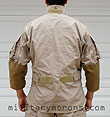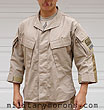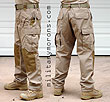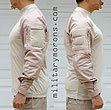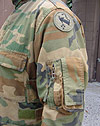Uniforms/Military Clothing page 1 page 2 page 3 page 4
TO VIEW FULL SIZE IMAGES: USERNAME and PASSWORD are both "mm"
EMDOM-MM CBDU (Contractor BDU)
| 7/25/09 - This is the CBDU (Contractor BDU) from EMDOM USA. It's a limited-run custom modified BDU shirt and pant that was originally designed as an enhanced BDU for private military contractors, or anyone else that can make use of its practical features. This project actually started in December 2006, when Ken from EMDOM asked me if I had any ideas for modified BDUs. 'Custom/enhanced' BDUs have become more commonplace now; back then all you had were BDUs that you took to the tailor to modify. Most of the BDUs were geared towards the military; less so for the civilian or PMC. Since PMCs can't wear camouflage, and some civvies dislike wearing camo to tactical classes etc, there were some modifications that I had in mind that I thought would be practical, and that I could make use of on the range while running around. So, while these BDUs can be worn by anyone who can use its features, we always referred to them as the 'Contractor BDUs', so the name stuck. The main goal was to provide practicality, additional elbow and knee protection, comfort and load bearing capability over the standard BDU without a noticeable increase in weight.
The CBDU is built from Propper 65% poly 35% cotton Battle Rip (ripstop) BDUs. They are purchased, then sent to a tailor for modification, who has to remove stitches, modify them and add on the extra features. They're not built from scratch at a factory. As a result, they're not inexpensive. This project took a long time, simply because other projects were always on the front burners. As more improved models of BDUs were introduced by manufacturers, I was ready to abandon this project as there were a lot of good BDUs out there with excellent features. But, we decided to continue with it because there weren't any that had the exact combination of features that we added in the CBDUs or a couple of the more unique features. The development process would be an iterative one, where Ken at EMDOM would bring the BDUs to the tailor, who would make the requested changes, return them to Ken who would send them to me for testing and evaluation, and I'd send them back to him with more changes and alterations. All the minor tweaks took a lot of time, but we eventually arrived at the final version you see here. CBDU Shirt - The CBDU Shirt was designed primarily as a warm weather BDU top, with its unique 3/4 length sleeves, but that provided more elbow protection with 500D cordura reinforcements.
Features - Here's a summary of the features on the EMDOM/MM CBDU shirt:
CBDU Pant - The idea for the CBDU pant was to enhance a standard Propper Battle Rip BDU pant on which it is built by adding some practical features that add utility and durability to the original product. The size Medium/short CBDU pant is shown here. I'm 5' 7" with a 29" inseam (short legs).
Features - Here's a list of the features on the CBDU Pants:
Notes - The Contractor BDUs were intended for warm weather use, when just a t-shirt doesn't provide enough protection. Wearing the CBDU shirt is obviously hotter than just a t-shirt, but the added protection and load bearing capability are features that the user must weigh. By featuring 500D cordura elbow and knee patches, abrasion resistance and protection against minor scrapes has been added without a noticeable increase in weight. By making them double as pad pockets, additional foam pads can be added without the inconvenience and discomfort of straps. Overall quality of the Propper Battlerip BDUs is very good, as far as BDUs go, and the tailor has done a decent job on the modifications. With my prototype, there was only one issue with attention to detail that I was dissatisfied about - the ends of the webbing for the additional belt loops were not heat cut or sealed, and started to unravel when I pulled a belt through. I brought this up to Ken and he had the tailor make sure that he sewed an additional line across near the end and also stitch the cut end down to prevent this from happening on the production versions. I've been wearing the prototype CBDU pants for at least a year, and the production version for a few months, for every day wear. I wear the top at the range when I can. Out at the range, the 500D cordura on the knees and elbows do provide some relief from stones and brass cases when shooting from prone, and adding pads inside the pockets makes them all the more comfortable. The pads inside the pockets don't shift around or slip, and are lighter and more comfortable than external/separate knee and elbow pads. Other BDUs also have pad pockets, but unless they're made of a tougher fabric like nylon, instead of the same fabric as the BDU, they can be subject to quite a lot of wear and tear and start wearing thin and rip if you take a knee often, and especially if you have knee pads inside. For small items, I use the front pelvis pockets most frequently, just like the front besom pockets on other brands of pants. I'm so used to having them I miss them if they're not present. The elastic loops inside the side cargo pockets really work well, in my opinion. If there's an item that will fit, like an M4 mag; it's held against the leg and is much easier to retrieve than if it were horizontal at the bottom of the pocket. Using the elastic loops for heavier items keeps them close to the leg for less swaying. If you put two full mags in each pocket, they WILL sway around when you run. There's no stopping that. It's not the most comfortable, but it's a lot better than loose mags inside the pockets. Also note that I've run around with four mags (two in each pocket), and a good belt is essential as the substantial weight will try to pull your pants down. If you're planning on carrying four mags as a habit, simple suspenders might be a good idea. Anyway, the elastic is there if you need it.
In summary, the EMDOM/MM CBDU is a set of khaki BDUs that offer more elbow and knee protection than a regular set, with some different features than what's currently offered on other BDUs.
|
| 11/4/10 - The Chimera Shirt LS from Arc'teryx LEAF (Law Enforcement & Armed Forces) line is a highly articulated, very light weight long-sleeved combat shirt. It's one of LEAF's newest armour-compatible garments and its light weight makes it suitable for the hottest weather. Named after another mythological beast like the Arc'teryx Gryphon half shell, the Chimera was initially designed as a jungle shirt, providing the minimum amount of protection to be worn with full kit in a hot, wet environment. The users who requested the development of the Chimera wanted a militarized version of the Arc'teryx Ether Comp Crew LS shirt. The features requested were an extended collar for neck protection from slings and commo wires, bicep pockets, velcro on the sleeves, and American-sourced materials for Berry compliance. The Chimera was the result, and initial field testing showed that the fabrics selected were more durable than expected. The Chimera is recommended for hot and humid conditions where keeping your core temperature low and quick-drying performance is more important than flame resistance and no melt/no drip properties.
Materials - The Chimera is made up of two American-sourced fabrics. The yoke, shoulders/sleeves are made of Tweave® Durastretch® LT 520e, and the torso/underarms are Cyberknit 571n. Tweave® Durastretch LT 520e is a technical stretch woven with 92% nylon and 8% lycra spandex. It is a durable, abrasion resistant, water and wind resistant, low-bulk, breathable fabric with excellent stretch and recovery properties. The Multi-directional (4-way) permanent-stretch spandex has 100% memory for shape retention. The LT 520e is a lighter weight version of the 520e used on the Gryphon. Cyberknit 571n is a very light and stretchy, moisture-wicking100% polyester fabric similar to a bike jersey or other lightweight performance top. It's anti-microbial treated to repel odours. The Chimera is available in Crocodile and Black.
Here are the main features of the Arc'teryx Chimera LS Shirt (Crocodile, Medium shown):
Observations and notes - The Chimera is listed on the LEAF site as having an 'athletic fit', and that usually means 'snug' to me based on past experience with Arc'teryx products. It's definitely a relaxed fit; not snug, and will fit a wider range of body types than some of the more form-fitted Arc'teryx garments. It's sized like a light weight long-sleeved t-shirt, but not as baggy in the torso. It's a comfortable cut, with enough stretch and room to allow unrestricted range of motion, and without much excess to add bulk under a rig or armour. It's low profile enough to wear as a base layer under another top like an Alpha LT. The collar design is interesting; there's an outer collar sewn at the rear of the the standard crew neck collar to protect the neck against abrasion from slings, wires etc. When I first donned the Chimera, I heard a popping sound from the neck seam, and saw that a couple of stitches had popped on the second line of stitching that holds the primary seam flat. I promptly forgot about it and put it through use and the washing machine/dryer a half dozen times before I was reminded of it again. It hadn't unraveled or gotten worse, so I'm not worrying about it. I did bring it up to Arc'teryx, and they said that there should be no degradation of performance from the current construction, but they're still going to switch back to the neck stitching they used on the inital samples. As mentioned above, it can be considered as a jungle version of a Combat shirt, for use in hot and wet environments where FR or no melt/drip is not a requirement. The Chimera is very lightweight, and I was very interested in seeing how the Tweave LT 536e material would perform. This was the first time I had encountered the LT 536e material, and I was a bit skeptical about the use of Tweave in a hot, sweaty environment. I wore the Chimera in the desert and also at some range shoots over the summer. The temperature one of those range days was over 100°F and the desert was in the 90°s. I was pleasantly surprised to find out that it actually performed very well, and didn't feel stifling nor stuffy in the heat. In fact, I found it more comfortable than standard NYCO BDU sleeves.
Upon closer examination, I discovered that the 536e fabric is actually more breathable than NYCO or 100% cotton ripstop BDU fabric. I did an unscientific 'blow test', where I held a single layer of fabric over my mouth and tried to blow through it forcefully, and compare the resistance between fabrics. The 536e fabric was significantly easier to blow air through. While the other BDU fabrics are very resistant to allowing air to be forced through, I can expend a full breath of air through the 536e very quickly, with almost no resistance. The larger 'pores' in the weave of the 536e is the key to allowing air to pass through the fabric while providing protection from radiant heat from the sun.
I also wore it while running on some hot days, but didn't get a chance to test it in a very humid environment. When running, I was of course pouring sweat, and the torso fabric would soak through and evaporate the sweat. The sleeves don't really soak up sweat, but my arms didn't feel any wetter/sweatier than when I run with bare arms. The Chimera doesn't hold moisture like a cotton top, nor does it get as clingy and heavy when wet. I lived in the tropics (S.E. Asia) for 9 years, with high humidity, monsoon seasons and bugs all over the place. No matter what I wore, I was always sweaty - there was no avoiding it. Back then, a very thin/light cotton top would be recommended for day trekking in the jungle, but any more than a couple of days and the cotton would take on a stink. During my last visits to the tropics, I compared both natural and synthetic garments and felt that synthetic garments had an edge over the natural ones, especially for extended use without the luxury of changing to clean, dry clothes every day. A lightweight synthetic top like the Chimera that doesn't hold water with and has an anti-microbial treatment is more resistant to rotting, smelling and falling apart in the jungle than natural fibers. To be honest, the tropics just suck, and I basically resigned myself to feeling constantly sticky and uncomfortable, no matter what I wore. Another good reason for wearing long sleeves in the jungle or forest is protection from the bugs and plants. Not only mosquitos, but friggin' huge ants, centipedes, scorpions, spiders, leeches and all sorts of other creepy crawlies. There are also stinging plants and razor-sharp grasses that will slice you open. I also wore it when the weather got colder, and it works very much like a lightweight baselayer, and fits well under other garments like the Alpha, or Atom LT.
As far as abrasion resistance goes, I shot from prone when in the desert on rocks/sand and on dirt/concrete at the range. The thin fabric offers no padding for the elbows, but I observed no noticeable wear after cleaning the dirt off. In my limited experience, Tweave Durastretch is very abrasion resistant and holds up well to wear. As mentioned before, reports from the field have proven the Chimera to be very durable. The high rear collar does provide more protection than a regular crew neck against a sling, the sun, or hot flying brass. The sleeve cuffs are the same material as the torso, and stretch enough to pull back the sleeves up the fore arm. The only thing I'd change on the Chimera would be to get rid of, or relocate the heat-transferred ID label inside the shirt on the upper back, which is put there for identifying the shirt with a permanent marker like a Sharpie. No biggie, but I could notice that little patch stick to me under gear occasionally since it doesn't breathe. I think it'd be better located at the bottom hem of the shirt. It's a nitpick, yes, but there's very little to complain about the Chimera.
|
Massif Lightweight Tactical Shirt
| 12/28/11 - The LTS (Lightweight Tactical Shirt) from Massif is a long-sleeved tactical shirt designed for hot-weather, high exertion missions that don't require FR protection. The Lightweight Tactical Shirt follows on the heels of the Integrated Tactical Jacket, which was Massif's first item in their line of non-FR clothing. While Massif has built its reputation on FR gear, their understanding of the end users' needs and experience when it comes to tactical clothing design translates well into the non-FR garment arena. It made perfect sense to start their own non-FR line (which started with the ITJ) to provide gear to customers who like Massif's designs and high performance fabrics, but don't need FR protection.
Materials - The LTS uses two different stretch-woven fabrics in its construction. The sleeves and yoke feature a stretchy, 83% nylon/17% spandex fabric that disperses moisture for rapid drying and has a DWR finish for rain protection. It's a completely matte finish, smooth-face fabric. The breathable torso fabric is a 77% polyester/23% nylon ultra light fabric with a fine visible grid pattern. It's not as stretchy as the sleeve/yoke fabric, and has permanent antimicrobial properties to prevent odour buildup. The LTS is available in OD Green (shown here) and Black/Grey.
Here are the main features of the Massif Lightweight Tactical Shirt (OD Green, size Medium shown):
Observations and notes - The LTS is a very light weight shirt, weighing only 8 oz. The first thing I noticed when donning it was that the sleeve cuffs didn't have any elastic nor velcro tab adjustment. I was surprised as this was different from every other Massif top I had. I asked Massif about this, and they replied "...we’re always trying to balance performance & functionality with the needs of the end user. We’ve traditionally put some type of fastener on the wrist because of either cold weather, FR requirements, or sand storms. For this shirt, we envisioned a different end user (law enforcement, SWAT teams, etc.) that wouldn’t necessarily encounter these issues. Our design team decided to go with a more streamlined sleeve, taking advantage of the stretch in the fabric & tapering the sleeve so that it was more narrow in the cuff." While I understand their rationale for going with the open cuff design, I feel that an elasticized cuff or adjustable one like that on their LTJ would have been better, as I like being able to adjust the cuff as needed. Being able to cinch it around my wrist ensures that it doesn't interfere with my gloves, no sand/debris enters when prone, no hot casings from shooting go down the sleeve (I've had this happen once with an open cuff - it was from someone else's gun), and there's no open cuff that might snag when I go down for the handgun. Another reason I like an adjustable cuff is that I don't like the cuff to come down to my hand, where it might interfere with something. You can see that the cuff extends past my wrist down to my hand, and I felt like I needed to keep pushing them back so they didn't touch my hands. When shooting, I resorted to folding the cuffs back so they were behind my wrist. The fit around the neck was also a bit loose - but I don't have a thick neck. I wouldn't have minded it being a little more close-fitting. Other than my dislike of the open cuffs, I was pleased with the rest of the shirt and impressed with its hot-weather performance. I wore the shirt at the range in unusually hot weather, where everyone else wore t-shirts, and was surprisingly comfortable in it. Due to the heat, I was sweating, but never felt sticky or that the fabric clung to me or got saturated. The long sleeves were also nice to have when shooting from the prone position, and to protect my arms from getting sunburned. The torso fabric is very breathable; air blown through it passes through with ease. The weave on the sleeve fabric is tighter, and doesn't let air through as easily. The tall collar protected my neck against the sun and was comfortable with a rifle sling. I didn't experience any chafing or discomfort from the sling. The Massif Lightweight Tactical Shirt is a great hot-weather shirt; one of the most comfortable 'combat-style' shirts I've worn. If the loose/non-adjustable cuff issue doesn't bother you, I'd recommend you give it a try.
|
| 2/7/09 - The Tru-Spec Combat Shirt available from USCAV is Tru Spec's 'Combat Shirt' -style garment which was pioneered by Crye Precision's Combat Shirt. This style of garment, with its BDU-fabric sleeves combined with a lighter-weight moisture wicking torso sans pockets, is a logical design for use under gear or body armour, and emerged in the Army's new Combat Shirt made by Massif and the USMC's FROG2 Combat Shirt (produced by Crye). The Combat Shirt concept addresses the main issues that personnel encounter when integrating body armour with their uniforms. First, the uniform chest and lower pockets cannot be reached when body armour is worn, rendering them practically useless. Not only is the weight unnecessary if they cannot be used, but they also add folds and bulk under the armour. Pockets are located on the sleeves/shoulders instead, where they can be readily accessed. The second issue is comfort. In hot weather, a standard BDU top under armour is hot and uncomfortable, as it's usually worn over an additional base layer, and doesn't breathe well. By having a torso made of a lightweight wicking, breathable baselayer fabric without any pockets, the Combat Shirt eliminates excess material and bulk under gear while increasing comfort when worn under body armour or gear. Materials - The TRU Combat Shirt is made up of two main fabrics - the shoulders/sleeves are either 50/50 NYCO rip-stop (UCP and Crye MultiCam) or 65/35 poly/cotton (black, khaki and OD), and the torso baselayer is 60/40 cotton nylon no melt, no drip Cordura® Baselayer fabric. Cordura® Baselayer - Baselayer is Invista/Cordura's new next-to-skin fabric that claims exceptional moisture management, comfort and durability while offering no melt/no drip thermal properties. It's not advertised as fire-resistant nor retardant, but just that it will not melt or drip onto the skin like polyester when exposed to high temperatures. It will act like most other natural fibers like cotton or wool and provide limited insulation against flame/flash fires. From the Baselayer press release:
Here are the main features of the TRU Combat Shirt (MultiCam, Medium shown):
Observations and notes - The first impression I got with the Tru-Spec Combat shirt was that it looked reasonably well put together. Quality of stitching looked on par with their other BDU offerings. The Cordura® brand Baselayer fabric is very comfortable - it's smooth, very soft, and feels like cotton with more stretch. The fit was good - relaxed around the torso without excess material. In comparison to the Crye Combat Shirt, the Tru-Spec covers more of the upper back with the ripstop fabric over the base layer for additional resistance to abrasion in a high wear area. Going over the shirt in more detail and examining the features, I found a few areas that I felt would benefit from changes/improvments.
Overall fit is good and so is comfort. The underarm gussets are nice. The arm length was perfect for me, but I have short arms. They might be a bit short for the lankier fellows. The torso length is long enough to stay tucked in under movement. I wore the Tru-Spec Combat Shirt at an all day range session and the torso was definitely cooler and less stuffy under gear than a BDU top, but with the added arm protection for which I was thankful. If I was wearing body armour or gear in hot weather, I'd definitely pick this over a BDU top. One thing to note is that the low collar is very comfortable, but doesn't protect the neck from a weapon sling rubbing on it, so take that into account. Using a sling with armour often puts it against the neck instead of sitting on the shoulder. When I'm wearing rigs or armour, I usually connect my rifle directly to the rig with the EMDOM/MM URS instead of using a sling, so that's not an issue.
Given that this is the first commercially available Combat Shirt offered by a major BDU manufacturer, it's a decent 'first cut'. They've got good materials and the comfort factor addressed. Other than my gripe with the shoulder pocket zipper location and the quality control issue, the other small details I can live with, but I'd still like to see Tru-Spec address them all. As-is, it's a decent value and will probably prove to be a very popular item. |
| 7/2/09 - Tru-Spec has released the second generation of their Combat Shirt, which I featured in the above writeup, and to my pleasant surprise, has greatly improved upon their first version. Concept and materials are the same, so please read the original writeup above for details. Here, I'll focus on the differences between the original release (I'll call that Gen 1) and the new one (Gen 2). The shirt shown here is a size Medium, in Khaki ripstop (65/35 poly/cotton blend).
Changes to the Combat Shirt - When I featured the first release of the Tru-Spec Combat Shirt back in February, there were some things that I felt could use some improvement. Since then, based on user feedback, Tru-Spec made some running changes to the design, which are seen on the Gen 2 Combat Shirt:
Observations and notes - I also noticed that the mock turtle neck collar on the Gen 2 is more snug than the one on my Gen 1. It's a better fit for me now. Everything else is pretty much the same - the Cordura® brand Baselayer fabric is very comfortable - it's smooth, very soft, and feels like cotton with more stretch. The fit was good - relaxed around the torso without excess material. One last thing I'd like to point out is that the colour shown is called Khaki, but it's more of a desert tan. In the photo above, you can see that the Khaki Combat Shirt sleeve is closer to the pinkish-hued desert tan in the U.S. 3-colour desert (DCU) pattern than the khaki/desert sand colours in the 3-colour desert pattern, or the khaki Propper shirt to the right. Under different lighting, the pinkish hue might be more or less noticeable. In the range pics below under bright sunlight, the pinkish hue is less noticeable. Also, the colour combinations for the Multicam Combat shirt are listed as Multicam/sand torso and the Khaki Combat Shirt as khaki sleeves/khaki torso. The torso on my Multicam shirt is exactly the same colour/material as the torso on the khaki combat shirt - it's a light sand. At the range session below, temperatures were much higher than when I wore the Gen 1 back in February, and the Gen 2 was very comfortable under my rig. No issues whatsoever. So, kudos to Tru-Spec for making the changes to their Combat Shirt so quickly, and for addressing even the smaller issues. The Gen 2 is much improved, and for me at least, now good to go.
|
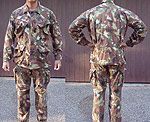 |
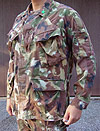  COMSUBIN jacket is made of a 'gaberdine' material, with cotton elbow reinforcements and pockets |
COMSUBIN BDU's Italy's COMSUBIN is an elite amphibious commando unit within the Italian Navy. Volunteers come mostly from the Battalion San Marco (Naval Infantry), whose members wear a very distinctive camouflage pattern, that has an 'airbrushed' look to it. This blends the colours better than distinctly separate colours would. The COMSUBIN pattern is similar to the BSM. This particular jacket is a COMSUBIN jacket made of a gabardine-like material and is cut baggy. The trousers seem to have 5% spandex in the material to give it a slight stretch. A lightweight and very comfortable set of BDU's. Thanks to Dr. Rich Mcaroy for helping me ID this set. For more info on this pattern and lots more, visit Mcaroy's page. |
South African Police (SAP) camo uniform
 Trousers |
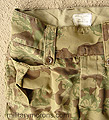 Closeup of right hip pocket |
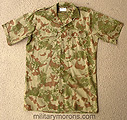 Short sleeved shirt |
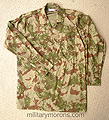 Long sleeved shirt |
 Field jacket |
|
|
ATTENTION! PLEASE DO NOT LINK DIRECTLY TO MY IMAGES
-
IT RESULTS IN MY BANDWIDTH ALLOCATIONS BEING EXCEEDED,
AND MY PAGES GO DOWN. THANKS!
/ . PLEASE
OBSERVE AND RESPECT OUR COPYRIGHT! . /
©opyright by MilitaryMorons.com. All Rights Reserved. Reproduction, Duplication,
Distribution Strictly Prohibited.
Unless mentioned otherwise, content and images are the
property of militarymorons.com and are not in the public domain.
They are not to be used without
permission. Please Contact
me for permission to use any images or content herein.



